Adalbert of Prague
Adalbert of Prague (Latin: Sanctus Adalbertus, Czech: svatý Vojtěch, Slovak: svätý Vojtech, Polish: święty Wojciech, Hungarian: Szent Adalbert; c. 956 – 23 April 997), known in Czech Republic, Poland and Slovakia by his birth name Vojtěch (Latin: Voitecus), was a Bohemian missionary and Christian saint.[3] He was the Bishop of Prague and a missionary to the Hungarians, Poles, and Prussians, who was martyred in his efforts to convert the Baltic Prussians to Christianity. He is said to be the composer of the oldest Czech hymn Hospodine, pomiluj ny and Bogurodzica, the oldest known Polish hymn, but his authorship of it has not been confirmed.[4]
Saint Adalbert of Prague | |
|---|---|
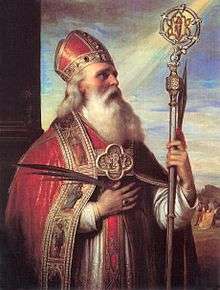 | |
| Bishop and Martyr | |
| Born | c. 956 Libice nad Cidlinou, Duchy of Bohemia (now the Czech Republic) |
| Died | April 23, 997 (aged 40–41) Święty Gaj or Primorsk, Prussia (now Poland or Russia) |
| Venerated in | Catholic Church Eastern Orthodox Church |
| Canonized | 999[1], Rome by Pope Sylvester II |
| Major shrine | Gniezno, Prague |
| Feast | 23 April |
| Attributes | spears [2] |
| Patronage | Poland, Czech Republic, Archdiocese of Esztergom |
St. Adalbert was later declared the patron saint of the Czech Republic, Poland and the Duchy of Prussia. He is also the patron saint of the Archdiocese of Esztergom in Hungary.[5]
Life
Early Years
Born as Vojtěch in 952[6] or ca. 956[7] in gord Libice, he belonged to the Slavnik clan, one of the two most powerful families in Bohemia.[6] Events from his life were later recorded by a Bohemian priest Cosmas of Prague (1045–1125). Vojtěch's father was Slavník (d. 978–981), a duke ruling a province centred at Libice.[8] His mother was Střezislava (d. 985–987),[8] and according to David Kalhous belonged to the Přemyslid dynasty.[9] He had five brothers: Soběslav, Spytimír, Dobroslav, Pořej, and Čáslav.[10] Cosmas also refers to Radim (later Gaudentius) as a brother;[11] who is believed to have been a half-brother by his father's liaison with another woman. After he survived a grave illness in childhood, his parents decided to dedicate him to the service of God. Adalbert was well educated, having studied for approximately ten years (970-80) in Magdeburg under the tutelage of St. Adalbert of Magdeburg.[12] The young Vojtěch took his tutor's name "Adalbert" at his Confirmation.
Episcopacy
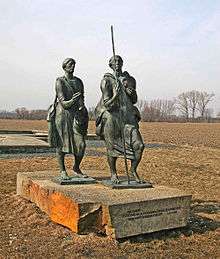
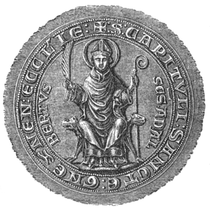
In 981 St. Adalbert of Magdeburg died, and his young protege Adalbert returned to Bohemia. Later Bishop Dietmar of Prague ordained him a Catholic priest. In 982, Bishop Dietmar died, and Adalbert, despite being under canonical age, was chosen to succeed him as Bishop of Prague.[13] Amiable and somewhat worldly, he was not expected to trouble the secular powers by making excessive claims for the Church.[14] Although Adalbert was from a wealthy family, he avoided comfort and luxury, and was noted for his charity and austerity. After six years of preaching and prayer, he had made little headway in evangelizing the Bohemians, who maintained deeply embedded pagan beliefs.
Adalbert opposed the participation of Christians in the slave trade and complained of polygamy and idolatry, which were common among the people. Once he started to propose reforms he was met with opposition from both the secular powers and the clergy. His family refused to support Duke Boleslaus in an unsuccessful war against Poland. Adalbert was no longer welcome and eventually forced into exile.[12] In 988 he went to Rome. He lived as a hermit at the Benedictine monastery of Saint Alexis. Five years later, Boleslaus requested that the Pope send Adalbert back to Prague, in hopes of securing his family's support. Pope John XV agreed, with the understanding that Adalbert was free to leave Prague if he continued to encounter entrenched resistance. Adalbert returned as bishop of Prague, where he was initially received with demonstrations of apparent joy. Together with a group of Italian Benedictine monks which brought with him, he founded in 14 January 993 a monastery in Břevnov (then situated westward from Prague, now part of the city), the second oldest monastery on Czech territory.
In 995, the Slavniks' former rivalry with the Přemyslids, who were allied with the powerful Bohemian clan of the Vršovcis, resulted in the storming of the Slavnik town of Libice nad Cidlinou, which was led by the Přemyslid Boleslaus II the Pious. During the struggle four or five of Adalbert's brothers were killed. The Zlič Principality became part of the Přemyslids' estate. Adalbert unsuccessfully attempted to protect a noblewoman caught in adultery. She had fled to a convent, where she was killed. In upholding the right of sanctuary, Bishop Adalbert responded by excommunicating the murderers. Butler suggests that the incident was orchestrated by enemies of his family.[14]
After this, Adalbert could not safely stay in Bohemia and escaped from Prague. Strachkvas was eventually appointed to be his successor. However, Strachkvas suddenly died during the liturgy at which he was to accede to his episcopal office in Prague. The cause of his death is still ambiguous. The Pope directed Adalbert to resume his see, but believing that he would not be allowed back, Adalbert requested a brief as an itinerant missionary.[13]
Adalbert then traveled to Hungary and probably baptized Géza of Hungary and his son Stephen in Esztergom. Then he went to Poland where he was cordially welcomed by then-Duke Boleslaus I and installed as Bishop of Gniezno.
Mission and Martyrdom in Prussia
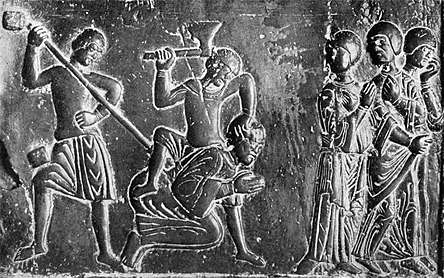
Adalbert again relinquished his diocese, namely that of Gniezno, and set out as a missionary to preach to the inhabitants near Prussia.[15] Bolesław I, Duke (and, later, King) of Poland, sent soldiers with Adalbert on his mission to the Prussians. The Bishop and his companions, including his half-brother Radim (Gaudentius), entered Prussian territory and traveled along the coast of the Baltic Sea to Gdańsk.
Success attended his efforts at first, but his imperious manner in commanding the people to abandon paganism irritated them, and at the instigation of one of the pagan priests he was murdered on 23 April 997 on the Baltic Sea coast east of Truso (currently the city of Elbląg) or near Tenkitten and Fischhausen (now Primorsk, Kaliningrad Oblast, Russia). It is recorded that his body was bought back for its weight in gold by King Boleslaus I of Poland.[16]
Veneration and Relics
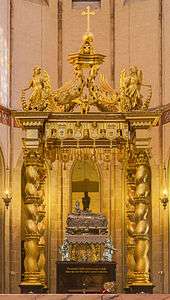
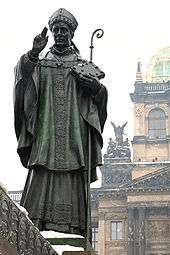
A few years after his martyrdom, Adalbert was canonized as St. Adalbert of Prague. His life was written in Vita Sancti Adalberti Pragensis by various authors, the earliest being traced to imperial Aachen and the Bishop of Liège, Notger von Lüttich, although it was previously assumed that the Roman monk John Canaparius wrote the first Vita in 999. Another famous biographer of St. Adalbert was St. Bruno of Querfurt who wrote a hagiography of him in 1001–4.
Notably, the Přemyslid rulers of Bohemia initially refused to ransom St. Adalbert's body from the Prussians who murdered him, and therefore it was purchased by Poles. This fact may be explained by the saint's belonging to the Slavniks family which was rival to the Přemyslids. Thus St. Adalbert's bones were preserved in Gniezno, which assisted Boleslaus I of Poland in increasing Polish political and diplomatic power in Europe.
According to Bohemian accounts, in 1039 the Bohemian Duke Břetislav I looted the bones of St. Adalbert from Gniezno in a raid and translated them to Prague. According to Polish accounts, however, he stole the wrong relics, namely those of St. Gaudentius, while the Poles concealed St. Adalbert's relics which remain in Gniezno. In 1127 his severed head, which was not in the original purchase according to Roczniki Polskie, was discovered and translated to Gniezno. In 1928, one of the arms of St. Adalbert, which Bolesław I had given to Holy Roman Emperor Otto III in 1000, was added to the bones preserved in Gniezno. Therefore, today St. Adalbert has two elaborate shrines in the Prague Cathedral[17] and Royal Cathedral of Gniezno, each of which claims to possess his relics, but which of these bones are his authentic relics is unknown. For example, pursuant to both claims the Saint has two skulls. The one in Gniezno was stolen in 1923.
The massive bronze doors of Gniezno Cathedral, dating from around 1175, are decorated with eighteen reliefs of scenes from the Saint's life. They are the only Romanesque ecclesiastical doors in Europe depicting a cycle illustrating the life of a saint, and therefore are a precious relic documenting Adalbert's martyrdom. We can read that door literally and theologically.
The one thousandth anniversary of St. Adalbert's martyrdom was on 23 April 1997. It was commemorated in Poland, Czech Republic, Germany, Russia, and other nations. Representatives of Catholic, Eastern Orthodox, and Evangelical churches traveled on a pilgrimage to the Saint's tomb located in Gniezno. Pope John Paul II visited the cathedral and celebrated a liturgy there in which heads of seven European nations and approximately one million faithful participated.
A ten-meter cross was erected near the village of Beregovoe (formerly Tenkitten), Kaliningrad Oblast, where St. Adalbert is thought to have been martyred by the Prussians.
In popular culture and society
The Dagmar and Václav Havel VIZE 97 Foundation Prize, given annually to a distinguished thinker "whose work exceeds the traditional framework of scientific knowledge, contributes to the understanding of science as an integral part of general culture and is concerned with unconventional ways of asking fundamental questions about cognition, being and human existence" includes a massive replica of St. Adalbert's crozier by Czech artist Jiří Plieštík.
St. Vojtech Fellowship was established in 1870 by Slovak Catholic priest Andrej Radlinský. It had facilitated Slovak Catholic thinkers and authors, continuing to publish religious original works and translations to this day. It is the official publishing body of Episcopal Conference of Slovakia.
Churches and parishes named for St. Adalbert
See also
- History of the Czech lands in the Middle Ages
- History of Poland (966–1385)
- Congress of Gniezno
- Gniezno Doors
- St. Adalbert of Magdeburg
- Saint Adalbert of Prague, patron saint archive
- Statue of Adalbert of Prague, Charles Bridge
References
- "Saint Adalbert Bishop of Prague", Encyclopædia Britannica
- Stracke, Richard (2015-10-20). "Hungarian Saints: Adalbert, Martin, Stanislas, Emeric and Stephen". Christian Iconography.
- Butler, Alban; Burns, Paul (1999). Butler's Lives of the Saints: April. A&C Black. p. 166. ISBN 978-0-86012-253-1.
- Vlasto 1970, p. 123.
- "Szent Adalbert". Katolikus.hu. Catholic Church in Hungary. Retrieved 7 March 2018.
- Molnar 1978, p. 12.
- Vlasto 1970, p. 97.
- Cosmas of Prague 2009, pp. 77–78.
- Kalhous 2015, p. 10.
- Cosmas of Prague 2009, p. 81.
- Cosmas of Prague 2009, pp. 87, 156.
- "St. Adalbert of Prague | Saint of the Day | AmericanCatholic.org". 2016-03-04. Archived from the original on 2016-03-04. Retrieved 2018-03-22.
- "St. Adalbert of Prague", Franciscan Media
- Butler 2003, p. 181.
- Monks of Ramsgate. “Adalbert”, Book of Saints (1921)
- "St. Adalbert of Prague", Catholic News Agency
- of Behemia's patron saint Adalbert find new resting place
| Wikisource has original works written by or about: Adalbert of Prague |
Sources
- Butler, Alban (2003). Butler's Lives of the Saints. Liturgical Press. pp. 181–. ISBN 978-0-8146-2903-1.CS1 maint: ref=harv (link)
- Vlasto, A. P. (1970). The Entry of the Slavs Into Christendom: An Introduction to the Medieval History of the Slavs. CUP Archive. ISBN 978-0-521-07459-9.CS1 maint: ref=harv (link)
- Molnar, Enrico S. (30 April 1978). "St. Adalbert - Missionary to three countries". The Living Church. Morehouse-Gorham Company: 11–12.CS1 maint: ref=harv (link)
- Kalhous, David (2015). Legenda Christiani and Modern Historiography. BRILL. pp. 10, 16, 26, 32, 44, 46, 57, 60, 72, 91–92, 111, 114–115, 117, 119, 130. ISBN 978-90-04-30589-2.CS1 maint: ref=harv (link)
- Althoff, Gerd (2010). Otto III. Penn State Press. pp. 3, 14, 27, 49, 60, 65–71, 91, 96–97, 99, 127, 137–138, 141–143. ISBN 978-0-271-04618-1.CS1 maint: ref=harv (link)
- Cosmas of Prague (2009). Wolverton, Lisa (ed.). The Chronicle of the Czechs. CUA Press. pp. 7–8, 15, 30, 49–50, 72, 75–83, 87, 96, 100, 107–109, 113–114, 117–120, 136, 156, 160, 176. ISBN 978-0-8132-1570-9.CS1 maint: ref=harv (link)
- Donald Attwater and Catherine R. John, The Penguin Dictionary of Saints, Third Edition (New York: Penguin Books, 1993); ISBN 0-14-051312-4.
External links
| Wikimedia Commons has media related to Adalbert of Prague. |
- "Adalbert of Prague" in the Ecumenical Lexicon of Saints (in German)
- Rudolf Grulich. "Der heilige Adalbert von Prag – ein Wegbereiter Europas" (PDF) (in German). kirche-in-not.de. Cite journal requires
|journal=(help)